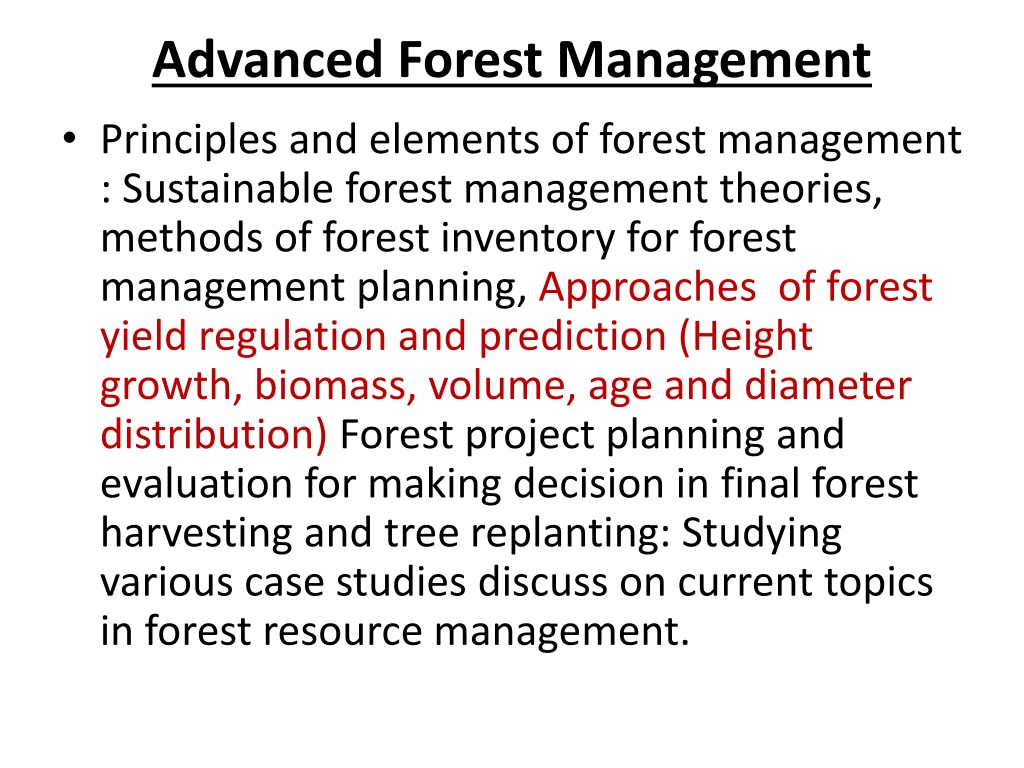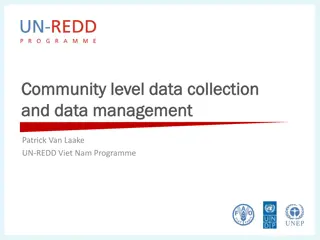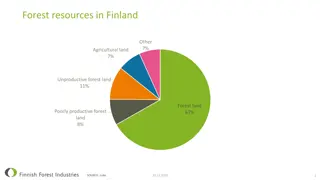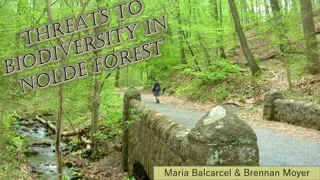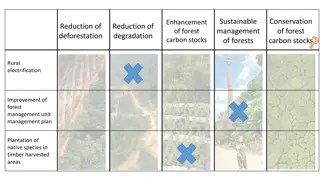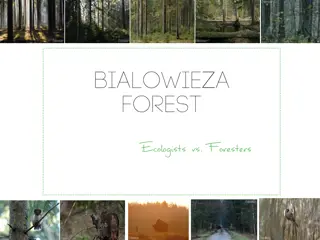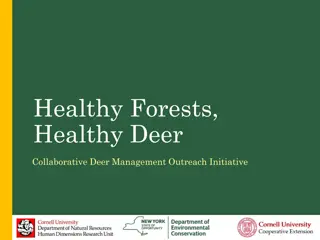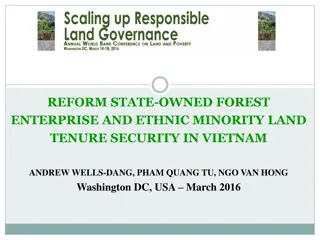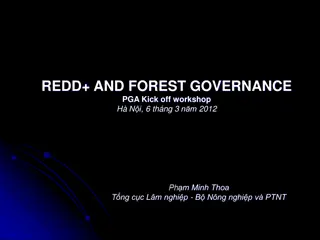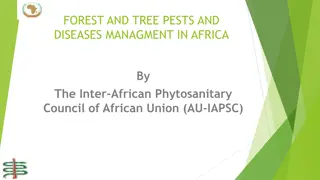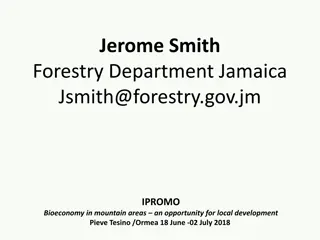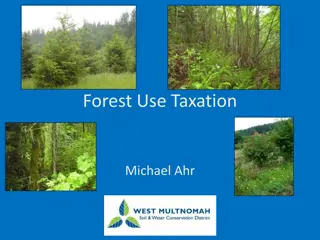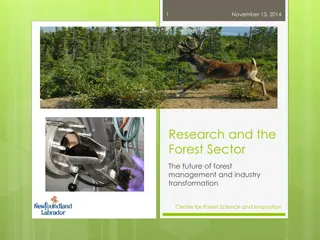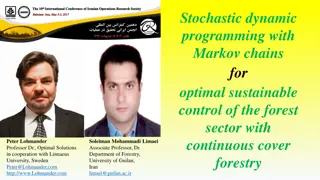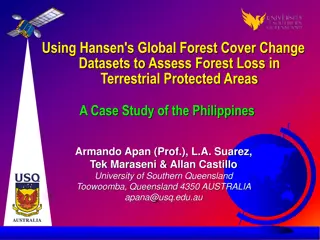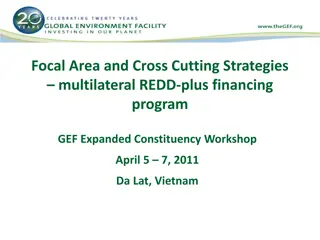Principles of Advanced Forest Management
Explore sustainable forest management theories, inventory methods, yield regulation approaches, and project planning for effective decision-making in forest resource management. Delve into the principles of forest management, land classification, growth projection, yield prediction, and sustainable practices. Learn about normal and uneven-aged forest yield regulation, decision-making strategies, and forest project evaluation through case studies. Enhance your understanding of forest resource management principles and elements.
Download Presentation

Please find below an Image/Link to download the presentation.
The content on the website is provided AS IS for your information and personal use only. It may not be sold, licensed, or shared on other websites without obtaining consent from the author. Download presentation by click this link. If you encounter any issues during the download, it is possible that the publisher has removed the file from their server.
E N D
Presentation Transcript
Advanced Forest Management Principles and elements of forest management : Sustainable forest management theories, methods of forest inventory for forest management planning, Approaches of forest yield regulation and prediction (Height growth, biomass, volume, age and diameter distribution) Forest project planning and evaluation for making decision in final forest harvesting and tree replanting: Studying various case studies discuss on current topics in forest resource management.
Course outline Introduction Defining forest management Objectives in forest management The scope of forest management Principles and elements of forest management: Land classification Growth projection and Yield prediction Prescriptions Sustainable forest management The concept of sustainability Principles of sustainable forest management Approaches of forest yield regulation The concept of normal forest Yield regulation for even-aged forest stands Yield regulation for uneven-aged forest stands Decision making in forest management and project planning
References Clutter, J. L and et al. 1983. Timber management: a quantitative approach. FAO. Guidelines for the management of tropical forests. FAO. Rome. Lawrence S. Davis & K. Norman Johnson. Forest Management. McGraw-Hill Book Company William A. Leuschner. Introduction to Forest Resource Management. John Wiley & Sons. Philip, M. 1983. Measuring trees and forests. T.E. Avery and H.E. Burkart. Forest Measurements. McGraw-Hill International Editions.
Forest management Encompasses all the process and practices undertaken in a forest area in order to lead and coordinate activities in forestry towards achieving some defined goals or objectives. Attempts to effectively integrate the biological, social and economic factors, which influence the decisions made towards the implementation of one or more specified objectives. Is the practical application of scientific, technical, and economic principles in forestry
Forest management is the process of applying the scientific, technical and economic principles of forestry in the planning, organization and implementation of forestry activities in order to achieve the objectives of forest owners (society). requires a plan assessment of the activities necessary to meet the objectives. recognition of the important ecological and social concerns associated with a forest the application of silvicultural practices so that a forest remains healthy and vigorous The range of forest management activities can include tree planting, weed control, fertilization, precommercial thinning, commercial thinning, final harvests, road construction, fire control, etc Each activities involves a cost and a benefit Choosing the type of activities, their timing, and placement is therefore important
Objectives of forest management Objectives are desired points the forest organization wishes to reach or the purpose that an organization strives to achieve Organization often have more than one objective Objectives can be classified as: Major(primary) and minor (secondary) objectives Direct and indirect objectives Objectives are defined at different levels National/regional wide objectives Project/local/forest based objectives Compartment level objectives
Nation Wide objectives often defined at sectoral policy levels Produce enough forestry products for the need of the people on a long term base Increase the forest cover and prevent desertification Maintain or enhance the biodiversity resources Project level: Production of lumber, construction poles and fuel wood for the local market Generate enough revenue to cover the cost of the project and allow additional investment Generate maximum revenue in the long term. Compartment/stand level: Maximum volume production of saw timbers. Production of good quality saw timber. Production of electric power transmission poles. Production of round wood up to maximum diameter.
Scope of forest management Forest management Is the practical application of scientific, technical, and economic principles in forestry Scientific Technical Economic Geography, Surveying Economics & Business Climatology Engineering Biology, Soil, Botany Ecology, Pathology, Zoology Entomology Wild life management Forest economics Protection Grazing , erosion Forest policy Control Forest Administration Silviculture Mensuration Logging, Utilization ForestManagement
Sustainable Forest Management Related to the concept of sustainable development Sustainable development is development which meets the needs of the present without compromising the ability of future generations to meet their own needs Rationales for SD Unequal distribution of benefits of development negative impacts of development on the environment Three aspects of SD Economic - able to produce goods and services on a continuing basis Environmental - avoiding over-exploitation of renewable resource systems or and depleting non-renewable resources Social - distributional equity, adequate provision of social services Therefore, sustainable forest management will ensure that the values derived from the forest meet present-day needs while at the same time ensuring their continued availability and contribution to long-term development needs wood and -wood products, water, food, fodder, medicine, fuel, shelter, employment, recreation, habitats for wildlife, biodiversity, carbon sinks and reservoirs, and for other forest products
Contd. Achieving SFM requires Understanding the factors/driving forces of unsustainable forest management, forest decline, or deforestation Immediate (direct) causes Underlying causes Understanding the principles that guide SFM Understanding the conditions that ensure SFM Immediate causes factors that directly result in deforestation Clearing for agricultural expansion, forest fires, logging Underlying causes - fundamental forces that originate from factors distant from agents of deforestation but influence their action Market failure Misguided policy interventions Population increase
Planning for sustainable forest management requires answering: Why and how SFM? ---- Principles of SFM Maximizing the welfare of today s and future society by maintaining the economic, environmental/ecological, social functions of forests How do we plan, implement, and monitor SFM? developing criteria and indicators related to the above functions of forests Principles of SFM top-level statements - fundamental truths or laws - which embody human wisdom about SFM. refer to a function of the forest or to a relevant aspect of the social system that interacts with it SFM should assure people s well-being SFM should assure healthy forest ecosystem There should be conducive environment for SFM (policy, law, regulations, institutions, etc)
Criteria and Indicators (C&I) of SFM Criteria - standards by which progress towards meeting the Principles can be judged define the particular state or conditions of the forest that we would expect to see if the Principle it supports is adhered to relates to a key management factor which may be described by one or more qualitative, quantitative or descriptive indicators. Indicators - Indicators are the components or variables of the forest or management system that imply or indicate the state or conditions required by a Criterion Are measurements to assess and evaluate the effects of forest management action, or inaction
C 2.1 The processes that maintain biodiversity in managed forests are conserved I 2.1.1 Landscape pattern is maintained I 2.1.2 Change in diversity of habitat as a result of human interventions should be maintained within critical limits I 2.1.3 Community guild structures do not show significant changes in the representation of especially sensitive guilds, pollinator and disperser guilds I 2.1.4 The richness/diversity of selected groups show no significant change I 2.1.5 Population sizes and demographic structures of selected species do not show significant change, and demographically and ecologically critical life-cycle stages continue to be presented I 2.1.6 The status of decomposition and nutrient cycling shows no significant change I 2.1.7 There is no significant change in the quality and quantity of water from the catchment I 2.1.8 Enrichment planting, if carried out, should be based on indigenous locally adapted species C 2.2 Ecosystem function is maintained I 2.2.1 No chemical contamination to food chains and ecosystem I.2.2.2 Ecologically sensitive areas, especially buffer zones along watercourses, are protected I.2.2.3 Representative areas, especially sites of ecological importance, are protected and appropriately managed I.2.2.4 Rare or endangered species are protected I.2.2.5 Erosion and other forms of soil degradation are minimized C 2.3 Conservation of the processes that maintain genetic variation I.2.3.1 Levels of genetic diversity are maintained within critical limits I.2.3.2 There is no directional change in genotypic frequencies I.2.3.3 There are no significant changes in gene flow/migration
The basic principle of tropical forest management comprise the following elements: National Policy and Legal framework Security of Tenure of Forest Resources and Land Effective Forest Protection Knowledge on Sustainability of Tropical Forest Ecosystems Maintenance of Site Productivity Forest Management Planning Goals and Objectives for Forest Management Definition of Forest Resources Application of Appropriate Silvicultural Systems Minimisation of Adverse Environmental Impacts A Regard for the Interests of Forest-Dependent Communities Commercial Sustainability and Business Management Monitoring of Managerial Performance
The Principle of Sustainable Yield The sustained yield of a forest is the total amount of material it can yield annually or periodically in perpetuity (for all time), without reducing the value of the forest. It is the yield a forest can produce continuously at a given intensity of management. implies continuous production so planned as to achieve a balance between increment (growth) and cutting (harvest). Sustained yield important for the following reasons keeps industries or markets constantly supplied and avoids periods of shortage or surplus promotes the establishment of stable prices which benefits both buyers and sellers make the best use of equipment and personnel allocated to the operations helps to provide steady employment for workers leads to a steady flow of regeneration and tending operations in the forest produces a regular flow of income for the owner of the forest
Elements of Forest Management Includes land classification, growth and yield predictions, prescriptions development Land classification is the first element since it sets the stage and context of the activities and yield prediction. classifying the forest management unit into homogeneous units with regard to relevant characteristics is is important done by considering some relevant features of the forest area are related to physical characteristics, vegetation characteristics, and development characteristics Physical characteristics includes the set of attributes used to characterize the permanent, physical nature of forest land, including topography, soils, bedrock, climate, hydrology Vegetation characteristics are the set of attributes used to characterize tree and other vegetation currently growing on forestland, including height, age, basal area, volume, diameter, etc. Development characteristics include the set of attributes used to characterize the organization, development and accessibility of forest land for human use, including ownership, roads, building etc
Example: Physical characteristics: Slope: Gentle (G), moderate (M), steep (S) Vegetation characteristics Forest type: Natural (N) vs Plantation (P) Natural Forest vegetation: closed (NC), disturbed (ND), open (NO) Plantation forest Vegetation: Cupressus (PC), Eucalyptus (PE), mixed (PM) Development Characteristics Accessibility to roads: close (<1km) (RC), far (> 1km) (RF) Settlements: close (<5km) (SC), far (>5km) (SF)
Physical characteristics S M G Vegetation characteristics
Accessibility RF RC Settlement
Forest map S, NC, RF, SF M,NC,RF,SF M,ND, RF,SF M,NO, RF,SF G,PM, RF,SF G,PE, RC,SC G,PC, RC,SC
Stands type: All forestland that has the same defined combination and attribute range of the physical, vegetation, and development characteristics chosen to classify the forest into homogeneous types with regard to some basic land characteristics in order to predict timber yield and other responses of the land to treatments with confidence E.g. All open natural forests situated on gentle slope area (at the foot of the mountain) that are close to the roads and surrounded by settlements All closed natural forests located on the mountains sides situated in the remotest parts of the forest and away from the surrounding communities Stand: A homogeneous, geographically contiguous parcel of land, all of the same stand type and larger than some defined minimum size Management unit/Block: An area of forest for which an approved Forest Management Plan is in operation. usually defined by watershed, ownership, or administrative boundaries for purposes of locating and implementing prescriptions. Compartment: is usually the smallest permanent subdivision (management units) of a forest. are permanently defined for the purpose of locating, describing, and record keeping and as a basis for the planning and management of all forest activities should be clearly demarcated on the ground and its boundaries should, as much as possible, follow natural features such as roads, rides, main ditches, banks or other surveyed lines.
Land cover classification of JamaUrji farmers managed forest area
JamaUrji farmers managed natural forest; Forest management prescription activities
